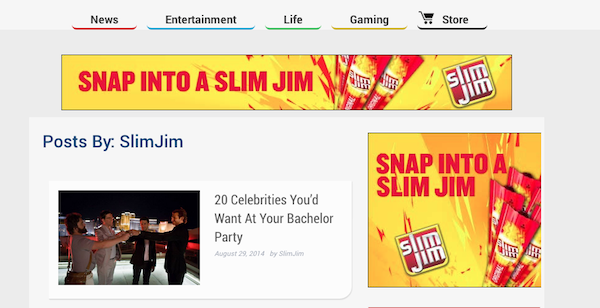
Having a native ad product is table stakes for publishers these days. But in addition to scale, the biggest challenge is coming up with content that people will actually read. For many publishers, the answer is to hire journalists to work on dedicated native ad teams.
There is another way: Sports and lifestyle upstart Rant is among a small but growing number of outlets, including Hearst Magazines, Dennis Publishing, Mail Online and Say Media, that use their editorial staff to write ad copy.
It’s a counterintuitive approach. Many publishers would say that their journalists can’t be independent and write ads. But Brett Rosin, CEO of the 4-year-old Rant, takes just the opposite tack. Rosin contends that since his edit staff (Rant has about 10 full-timers plus 400 outside bloggers) knows how to write eye-catching posts, they’re the best positioned to write copy for advertising clients that resonates with readers.
“The editorial team really controls what Rant has done successfully,” Rosin said. “To me, getting the editorial team involved ensures we’re going to have the most engaging content.”
A recent ad campaign for SlimJim shows this practice in action. For the meat snack, one of about a half-dozen native ad clients to date, Rant created a series of articles including “20 Best Movies To Watch With The Guys” that may have light mentions of SlimJim. The pieces also credit SlimJim as the author and are surrounded by traditional display ads.
Rosin said the numbers show that his approach works: The campaign got 250,000 visitors in the two months it has run. Visitors have averaged 25 pages per visit, helped, no doubt, by the campaign’s heavy use of slideshows.
The edit staff is involved from the get-go, working on story ideas while the client is still being pitched. Mail Online says writing native ads is voluntary for its journalists and sometimes is rewarded with extra pay; at Rant, writing ad copy is just considered part of the job. The client has final sign-off.
The SlimJim content may be innocuous. But it’s easy to see how Rant’s approach could run into trouble in the news category, where the reporting can take an adversarial tone. An IAB-Edelman study found that among news, business and entertainment, news consumers were the least receptive to sponsored content.
Rant has 14 verticals that include RantSports, RantCars, RantGizmo and RantMovies, so it covers a lot of ground editorially. But rather than shy away from conflicts, Rosin said Rant doesn’t restrict what topics editorial staff can write about for advertisers. So theoretically, a writer could write a negative story about an automaker one day and then write a native ad about the same company. Rosin believes that there’s no problem as long as Rant is transparent with the advertiser. (It’s not always transparent to the reader, though; Rant doesn’t run author bylines on the native ads unless the brand asks it to do so.)
“When we talk to the brands, we’re pretty open that our writers are going to cover everything honestly,” Rosin said, adding that if the brand is the subject of bad news, Rant’s native ads, which it calls BrandRant, can serve a PR purpose.
“When we talk to the brands, we’re open about how our writers’ editorial duties are separate, so our staff covers stories with the same honesty that makes our brand successful,” he said. In the theoretical case of a car recall, he added, “If there’s a recall, we’re going to say to the auto brand, ‘We know this is out there, so let’s help you come up with a campaign with the right brand message.'”
Steve Rubel, chief content strategist for Edelman, said that Rant’s model is not unlike how radio announcers read sponsor messages. It’s possible to use journalists at publishing companies to write ads and keep the editorial integrity intact, he said, depending on the type of article and topic. For a young company, using existing staff also might be a way to keep costs down.
“When it’s not as hard-hitting, it’s easier to manage that switch,” he said. “If you’re writing about fashion, style, entertainment, the sponsors are not necessarily in disagreement with the editorial content. Where it falls apart is in business, and news for sure. It’s certainly important for the brand to be very clear with the readers, so there’s full transparency.”
More in Media

From sidelines to spotlight: Esports events are putting creators center stage
Esports events’ embrace of content creators reflects advertisers’ changing priorities across both gaming and the wider culture. In the past, marketers viewed esports as one of the best ways to reach gamers. In 2025, brands are instead prioritizing creators in their outreach to audiences across demographics and interest areas, including gaming.

Condé Nast and Hearst strike Amazon AI licensing deals for Rufus
Condé Nast and Hearst have joined the New York Times in signing a licensing deal with Amazon for its AI-powered shopping assistant Rufus.

Media Briefing: AI payouts may be entering a new era
AI compensation is evolving — and new models, not just publisher demands, are driving the shift beyond flat-fee licensing.






